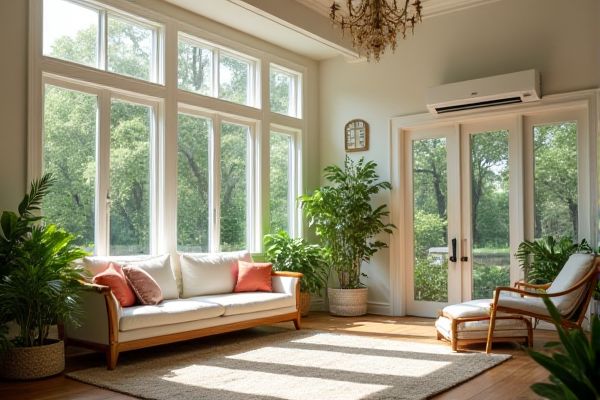
Choosing between a split AC and a portable AC for your sunroom depends on factors like installation, cooling efficiency, and space preferences. Learn more about which option suits your sunroom best by reading the full article.
Table of Comparison
| Feature | Split AC | Portable AC (Sunroom) |
|---|---|---|
| Installation | Permanent, wall-mounted with outdoor unit | Temporary, easy setup, requires venting through window |
| Cooling Efficiency | High efficiency, suitable for large rooms | Moderate efficiency, best for small spaces like sunrooms |
| Portability | Fixed installation, not portable | Portable, can be moved between rooms |
| Noise Level | Low noise, compressor located outside | Higher noise, compressor inside the unit |
| Cost | Higher initial and installation cost | Lower upfront cost, no installation fees |
| Energy Consumption | More energy-efficient, lower operating cost | Consumes more energy per BTU, higher electricity bills |
| Space Usage | Minimal indoor space, wall-mounted | Takes floor space inside the room |
| Maintenance | Requires professional service for outdoor unit | User-friendly, easier to clean and maintain |
Split AC vs Portable AC: Key Differences for Sunrooms
Split AC units offer superior cooling efficiency and quieter operation for sunrooms compared to portable ACs, which are generally less powerful and noisier. Split ACs require professional installation and permanent mounting, while portable ACs provide flexibility and mobility without complex setup. Your choice depends on balancing the need for consistent temperature control with installation convenience in your sunroom.
Cooling Efficiency in Sunrooms: Split AC vs Portable AC
Split AC units provide superior cooling efficiency in sunrooms due to their higher BTU capacity and dedicated compressor system, enabling consistent temperature control and faster cooling. Portable ACs typically have lower BTU ratings and rely on single-hose or dual-hose exhaust systems, which can reduce effectiveness in sunrooms with high sun exposure and limited ventilation. Energy consumption of split ACs tends to be lower per cooling output, making them more cost-effective for maintaining comfortable temperatures in sunroom environments.
Installation Requirements: Split AC and Portable AC Compared
Split AC units require professional installation involving mounting the indoor unit, securing the outdoor compressor, and establishing refrigerant lines through walls, making them more permanent and efficient for cooling your sunroom. Portable ACs need minimal setup with just a venting hose directed through a window or wall opening, offering flexibility but generally less efficiency and higher noise levels. Your choice depends on whether you prioritize permanent, effective cooling with a complex installation or quick, movable cooling with simple setup.
Space Considerations: Best Fit for a Sunroom
Split AC units offer efficient cooling with minimal space intrusion, making them ideal for sunrooms where wall-mounted installation preserves floor area. Portable ACs require floor space and a vent to the outside, which can be challenging in sunrooms with limited window or door access. You should assess the available installation options and room layout to determine the best fit for your sunroom's cooling needs.
Energy Consumption in Sunroom Settings
Split AC units typically consume less energy in sunroom settings compared to portable ACs due to their higher SEER (Seasonal Energy Efficiency Ratio) ratings and efficient ductless design. Portable ACs often require more power to cool sunrooms because of their lower cooling capacity and heat exhaust systems that reduce overall efficiency. Energy consumption in sunrooms is minimized by choosing split AC systems that provide consistent cooling with optimized energy use in enclosed spaces with large windows and high solar gain.
Cost Comparison: Upfront and Long-Term
Split AC units generally have a higher upfront cost due to professional installation and equipment expenses, while portable ACs are more affordable initially with minimal setup requirements. Over time, split ACs tend to be more energy-efficient, leading to lower electricity bills and reduced long-term operational costs compared to portable units. Your choice should weigh immediate budget constraints against potential savings from energy efficiency and durability.
Noise Levels: Which AC is Quieter in a Sunroom?
Split AC units are generally quieter in a sunroom because their compressor and condenser are installed outside, reducing indoor noise significantly. Portable ACs produce more noise as their entire system operates within the room, typically generating sound levels around 50-60 decibels. For noise-sensitive environments like sunrooms, split ACs provide a more peaceful cooling solution compared to portable units.
Portability vs Fixed Cooling: Pros and Cons
Split AC units offer efficient, fixed cooling ideal for consistent temperature control in sunrooms but lack portability, making them less flexible for changing layouts. Portable ACs provide mobility, allowing users to relocate the unit as needed, though they generally deliver less powerful cooling and can be noisier compared to split systems. Evaluating sunroom usage patterns and cooling preferences is essential to determine whether the fixed, high-efficiency cooling of split AC or the adaptable, movable nature of portable AC suits the space best.
Maintenance Needs for Split and Portable ACs
Split AC units require regular maintenance such as cleaning or replacing air filters every 1-3 months and professional servicing of condenser coils and refrigerant levels annually to ensure optimal efficiency. Portable ACs need frequent emptying of water collection trays or draining pumps, alongside cleaning or replacing filters monthly to prevent mold and maintain airflow. Both systems benefit from prompt attention to clogged filters and coils to maintain cooling performance and energy efficiency in sunroom environments.
Choosing the Right AC for Your Sunroom: Final Thoughts
Selecting the right AC for your sunroom depends on factors like cooling capacity, installation flexibility, and noise levels. Split AC units offer efficient cooling and quieter operation with permanent installation, while portable ACs provide mobility and easy setup but may be less energy-efficient for larger sunrooms. Assess your sunroom's size and ventilation to ensure your cooling choice maintains comfort without excessive energy costs.
 homyna.com
homyna.com